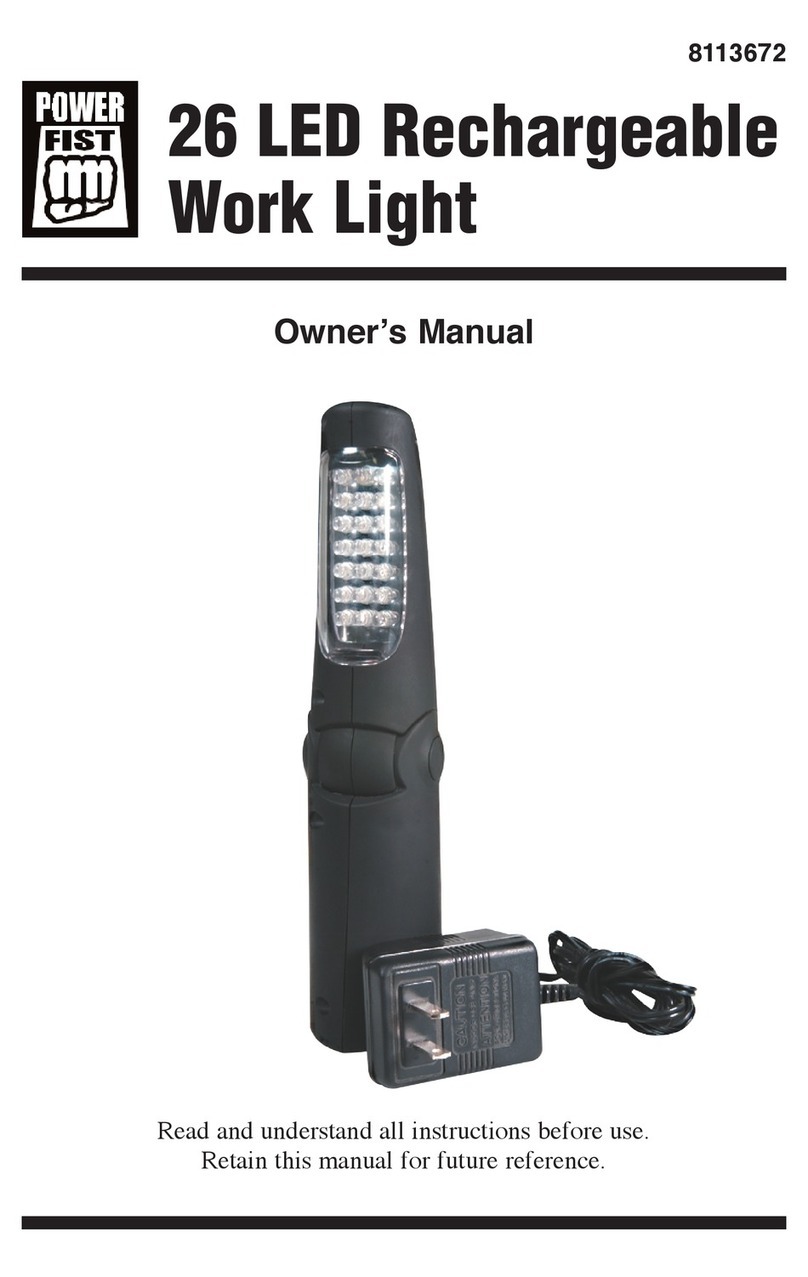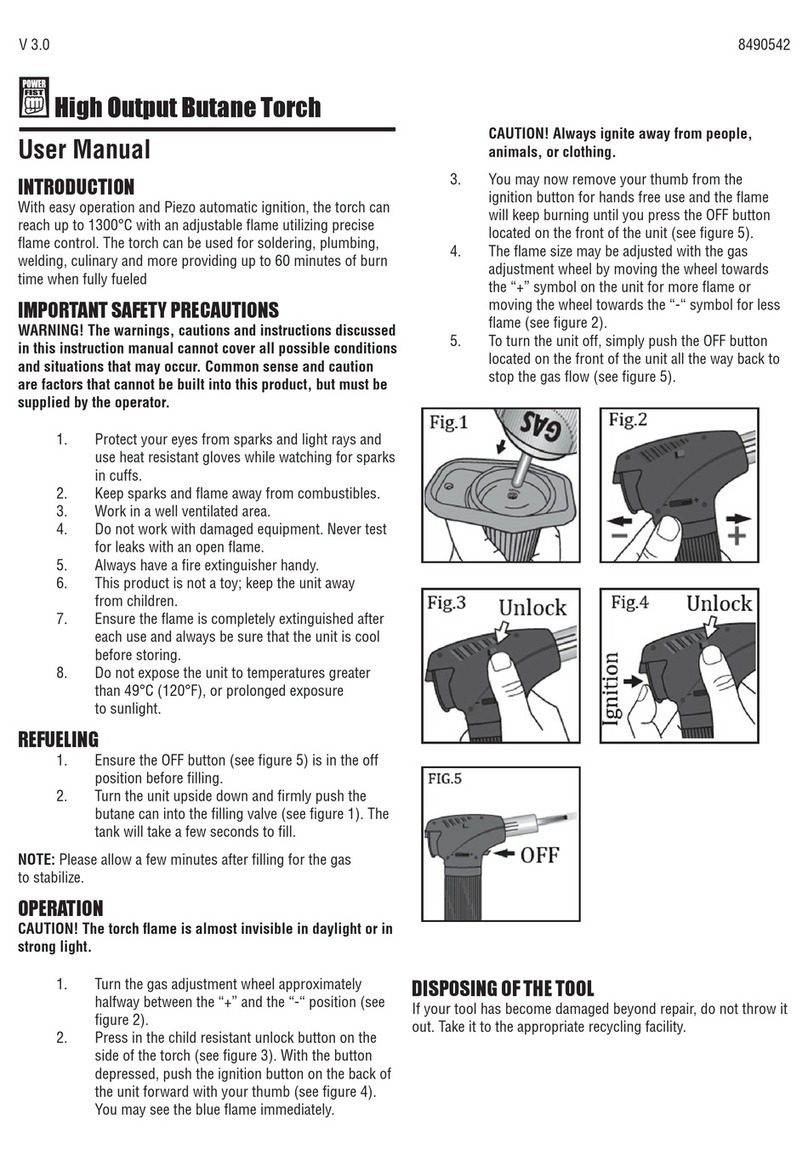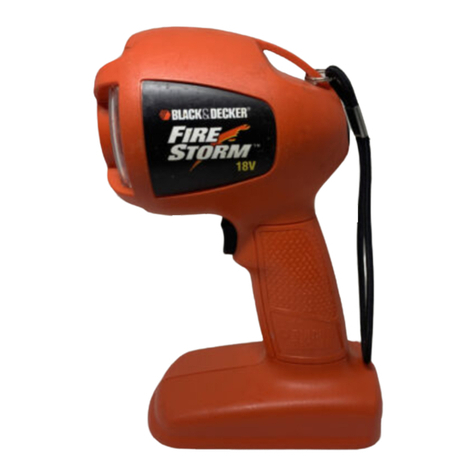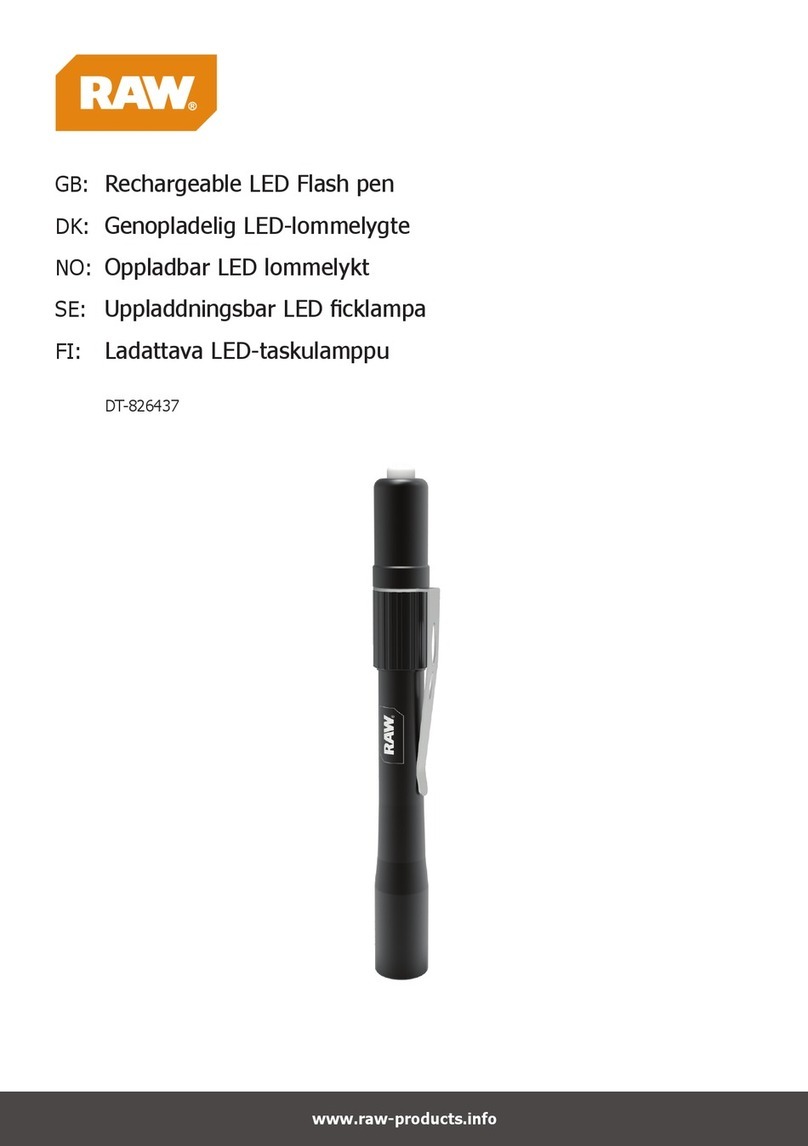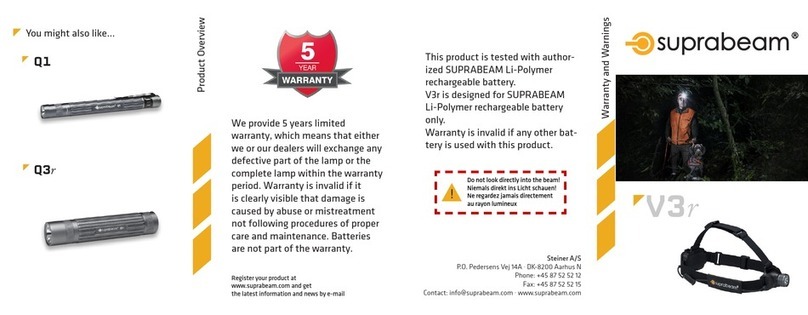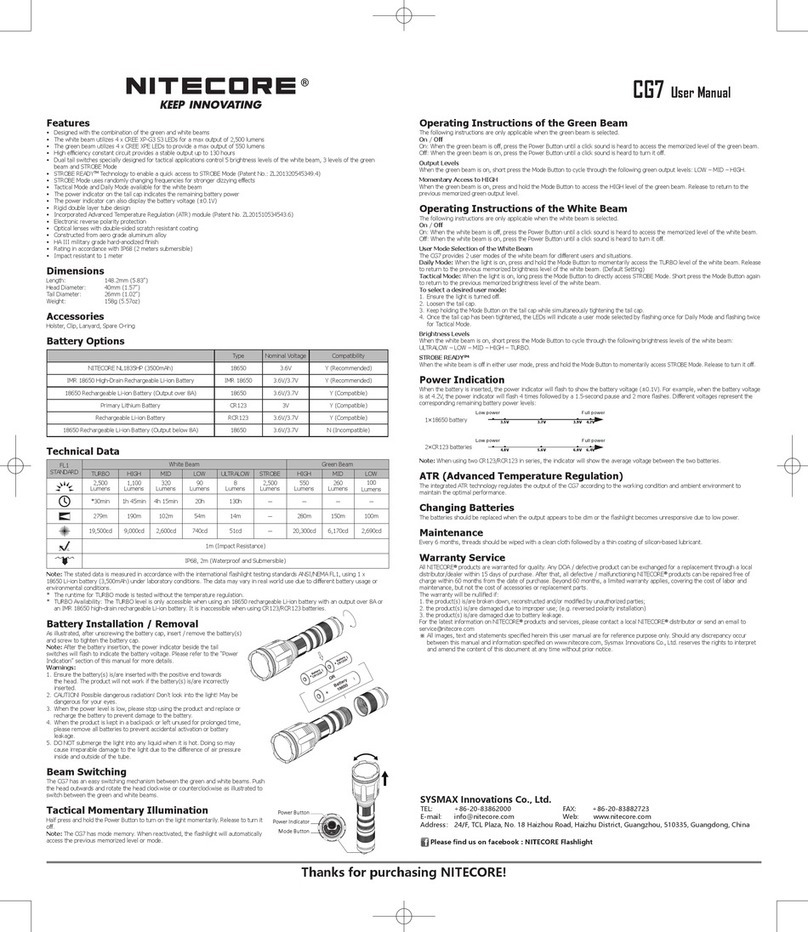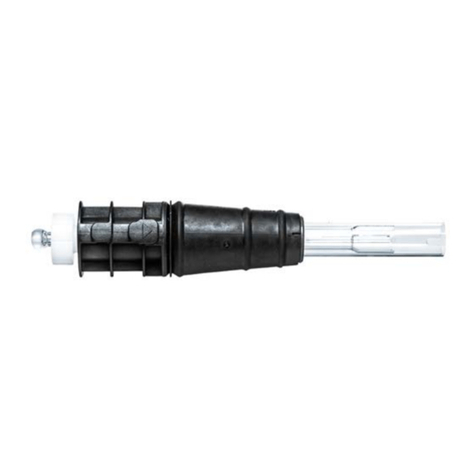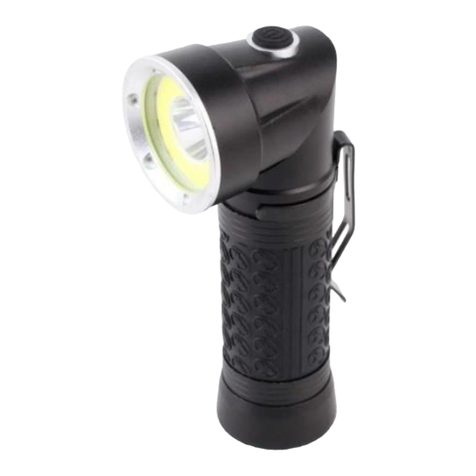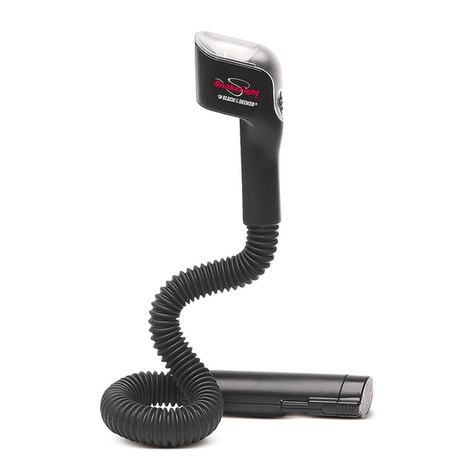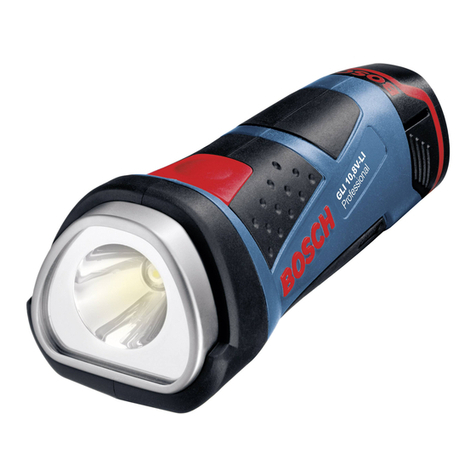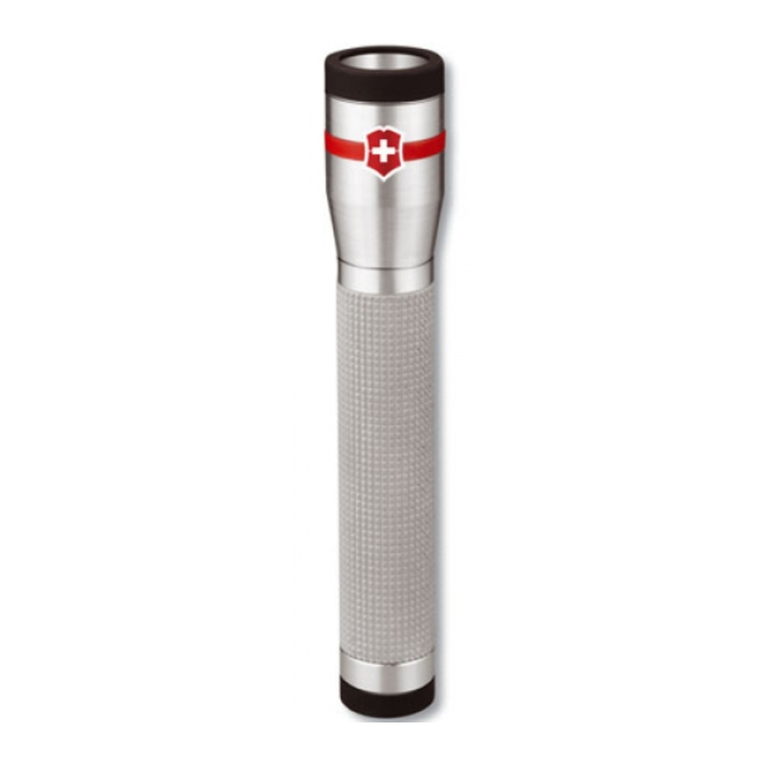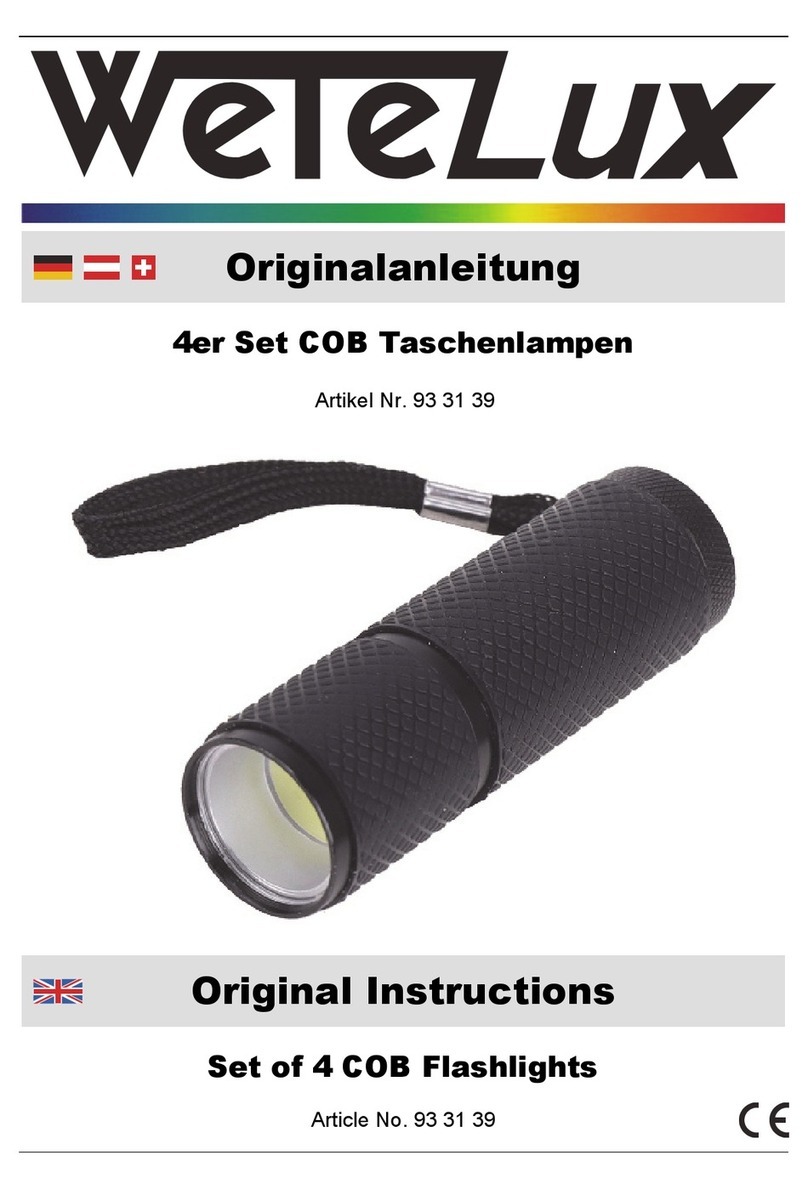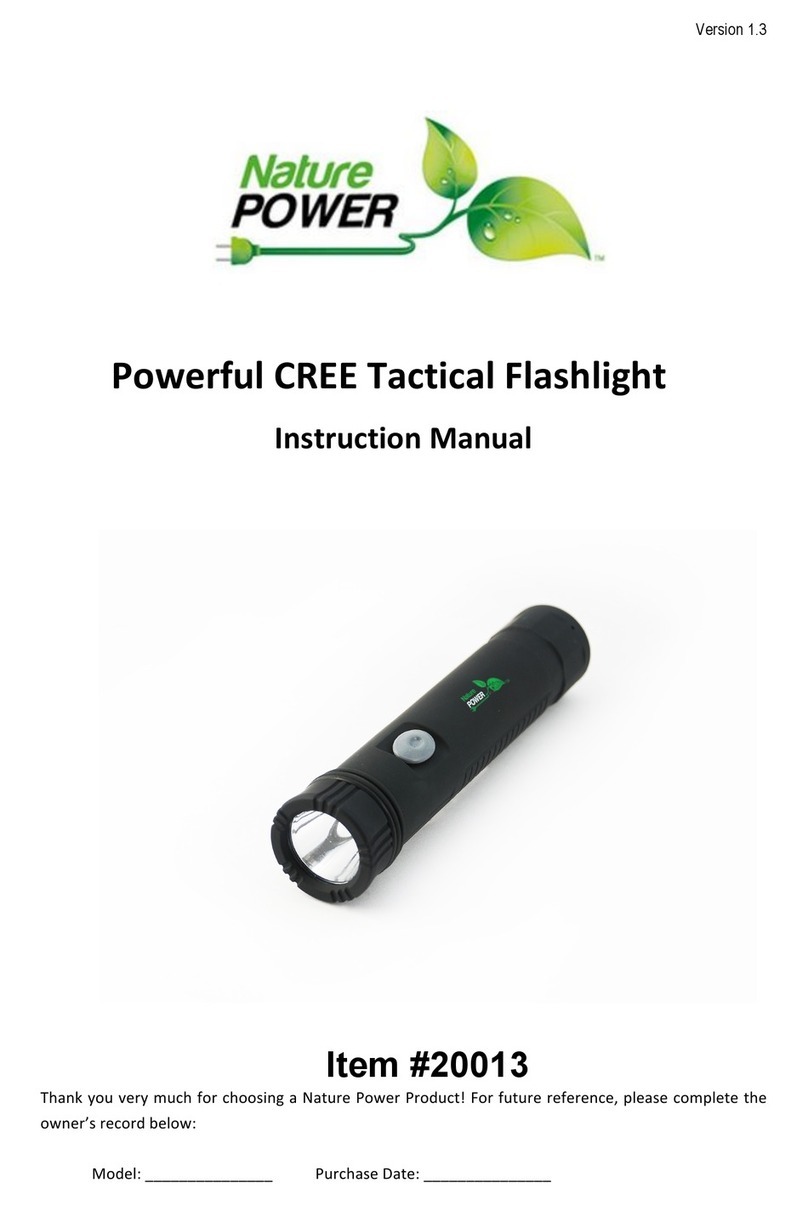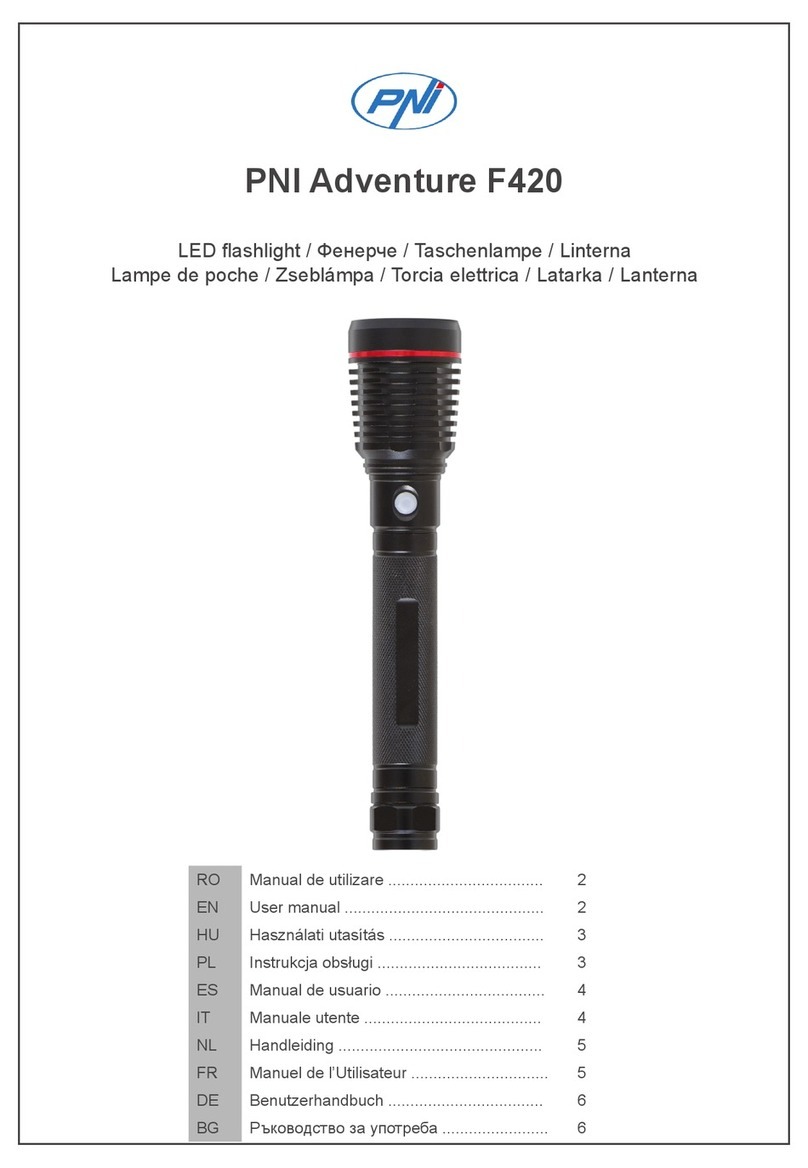Power Fist 8598195 User manual

V4.0 8598195
Please read and understand all instructions before use. Retain this manual for
future reference.
User Manual
Cutting,Weldingand
BrazingHoseTorch

8598195 Cutting, Welding and Brazing Hose Torch V4.0
2 For technical questions call 1-800-665-8685
SPECIFICATIONS
Torch Type Cutting, Welding and Brazing Torch
Gas Types MAPP® and Oxygen
Maximum Flame Temperature 5,300ºF (2,926ºC)
Flame Arrestor Yes
Hose Length 44 in.
Cylinders (not included) MAPP Yellow, Right-Hand Threads
Oxygen Red, Left-Hand Threads
INTRODUCTION
The Cutting, Welding and Brazing Hose Torch attaches to MAPP and Oxygen
cylinders (sold separately). The flame generated can be used for soldering, heat
treatment, cutting, brazing or welding.
Consult the safety and use instructions for the gas cylinders before using this torch.
SAFETY
WARNING! Read and understand all instructions before using this tool. The
operator must follow basic precautions to reduce the risk of personal injury
and/or damage to the equipment.
Keep this manual for safety warnings, precautions, operating or inspection and
maintenance instructions.
HAZARD DEFINITIONS
Please familiarize yourself with the hazard notices found in this manual. A notice
is an alert that there is a possibility of property damage, injury or death if certain
instructions are not followed.
Cutting,Weldingand
BrazingHoseTorch

V4.0 Cutting, Welding and Brazing Hose Torch 8598195
Visit www.princessauto.com for more information 3
DANGER! This notice indicates an immediate and specific hazard that will
result in severe personal injury or death if the proper precautions
are not taken.
WARNING! This notice indicates a specific hazard or unsafe practice that
could result in severe personal injury or death if the proper
precautions are not taken.
CAUTION! This notice indicates a potentially hazardous situation that may result
in minor or moderate injury if proper practices are not taken.
NOTICE! This notice indicates that a specific hazard or unsafe practice will
result in equipment or property damage, but not personal injury.
WORK AREA
1. Operate in a safe work environment. Keep your work area clean, well-lit
and free of distractions. Place lights so you are not working in a shadow.
2. Remove all unnecessary people from the work area when welding.
Anyone remaining in the work area must wear the appropriate welding
safety equipment.
3. Store unused tools properly in a safe and dry location to prevent rust or
damage. Lock tools away and keep out of the reach of children.
4. Do not install or use in the presence of flammable gases, dust or liquids.
5. Welding sparks and ejected molten slag can start a fire. Remove
combustible materials within 39 ft (12 metres) of the welding unit. See Fire
and Explosion Precautions.
6. Have a fire extinguisher readily available (see Fire and Explosion
Precautions).
7. Use protective screens or barriers to protect others from flash and glare;
warn others in the area to look away from the arc.
8. Keep the welding unit at least one foot from any wall or structure.
9. Check that the work area is free from fires, sparks or hot debris
before leaving.
10. Do not expose the torch or oxygen cylinder to flammable materials. Control
the oxygen gas carefully. Oxygen can ignite easily and accelerates how
quickly other flammable material will burn.

8598195 Cutting, Welding and Brazing Hose Torch V4.0
4 For technical questions call 1-800-665-8685
PERSONAL SAFETY
WARNING! Wear personal protective equipment approved by the Canadian
Standards Association (CSA) or American National Standards Institute (ANSI).
HEAD PROTECTION
DANGER! Never look directly at the welding arc without the proper
protection. The light can cause flash burn damage and impair vision.
Although treatment is possible, multiple occurrences can result in
permanent eye damage.
1. Protect your eyes from welding light by wearing a welder's helmet or
goggles fitted with a filter shade No. 4 or 5 while using the torch. Eye
protection equipment should comply with CSA Z94.3-07 or ANSI
Z87.1 standards based on the type of work performed.
2. An opaque helmet will protect against the ultraviolet or infrared light. A
helmet will also protect against ejected hot material and slag. The helmet
should protect the face, forehead, ears and neck.
a. Immediately replace a cracked or broken helmet or a scratched or
damaged lens filter to avoid damage to the eyes or face from an
infrared flash or ejected molten material.
3. Wear a fire-resistant head covering like a skull cap or balaclava hood to
protect your head when the faceplate is down or when using a welding
hand-held face shield.
4. Wear fire resistant ear plugs when welding overhead to prevent spatter or
slag from falling into ear.
PROTECTIVE CLOTHING
1. Wear a leather apron or jacket, leather welding gloves and full foot protection.
Choose clothing fabrics that resist sparks, heat, flames and splashes of molten
material. Artificial fabrics may burn and melt, resulting in a more severe injury.
a. Wear welding capes and sleeves when performing overhead welding.
2. Do not wear clothes or protective gear that are frayed, oily or greasy as
they may ignite from the heat or ejected slag and sparks.
3. Wear thick clothes that do not expose the skin. Ultraviolet or infrared light
can burn skin with sufficient exposure.

V4.0 Cutting, Welding and Brazing Hose Torch 8598195
Visit www.princessauto.com for more information 5
4. Do not wear clothing that can hold hot debris or sparks such as pant cuffs,
shirt pockets or boots. Choose clothing that has flaps over pockets or wear
clothing to cover the openings such as pant legs over the boots or an apron
over the shirt.
5. Wear non-skid soles to maintain footing and balance during work.
a. Select boots with steel toe protection to prevent injury from
falling objects.
RESPIRATORS
1. Respiratory protection is needed when ventilation is not sufficient to
remove welding fumes or when there is risk of oxygen deficiency.
a. Wear a NIOSH approved respirator when working on materials that
produce dust or particulate matter.
2. Work in a confined space only if it is well ventilated or while wearing an air-
supplied respirator. Welding fumes and gases can displace air and lower
the oxygen level causing injury or death. Be sure the breathing air is safe
(See Fumes and Gases).
3. The user can take the additional precaution of informing another person in
the work area of the potential danger, so that person can watch for
indications that the user is suffering from oxygen deprivation.
PERSONAL PRECAUTIONS
Control the tool, personal movement and the work environment to avoid
personal injury or damage to the tool.
1. Do not operate any tool when tired or under the influence of drugs, alcohol
or medications.
2. Avoid wearing clothes or jewelry that can become entangled with the
moving parts of a tool. Keep long hair covered or bound.
3. Do not overreach when operating the tool. Proper footing and balance enables
better control in unexpected situations.
4. Support the workpiece or clamp it to a stable platform. Holding the
workpiece by hand or against your body may lead to personal injury.
5. Do not wear any personal grooming products that are flammable, such as
hair preparations, perfume or cologne with an alcohol base.

8598195 Cutting, Welding and Brazing Hose Torch V4.0
6 For technical questions call 1-800-665-8685
6. Remove any combustibles, such as butane lighters or matches, from your
person before doing any welding. Hot welding sparks may light the
matches or ignite leaking lighter fuel.
SPECIFIC SAFETY PRECAUTIONS
WARNING! DO NOT let comfort or familiarity with product (gained from
repeated use) replace strict adherence to the tool safety rules. If you use
this tool unsafely or incorrectly, you can suffer serious personal injury.
1. Use the correct tool for the job. This tool was designed for a specific function.
Do not modify or alter this tool or use it for an unintended purpose.
2. Do not use the tool if any parts are damage broken or misplaced. Repair or
replace the parts.
a. The torch has a built-in flame arrestor. Immediately shut off the both
fuel cylinders if the flame disappears into the torch and you hear a
high-pitch sound. Consult the Care & Maintenance section to
determine if the torch tip requires replacement.
3. Use only the recommended fuel with this torch. Other fuels can damage
the hose and fittings, causing a gas leak.
4. Welding produces sparks and molten slag. A cooling bead can eject chips
or fragments of slag. Any of these can cause direct harm to the eyes or
skin of the user or bystanders.
5. Do not point the torch at yourself, bystanders, animals or flammable
materials. The MAPP / oxygen burns at a temperature that reaches 5,300°F
(2,295°C).
6. Disconnect both fuel cylinders when the torch is not in use.
7. Have a level surface to place the torch down. This will reduce the chance of
accidentally tipping the cylinders over. The torch must not point at anything
nearby that can ignite.
8. Do not handle hot metal, the torch or rod stub with bare hands. Handling
may result in a burn injury.
a. Use a tool to hold a brazing/welding rod. It may be hot even when the
end isn’t glowing.
9. Do not use the welding torch if personal movement is confined or if there
is a danger of falling.

V4.0 Cutting, Welding and Brazing Hose Torch 8598195
Visit www.princessauto.com for more information 7
10. Never dip the rod in water for cooling.
11. Do not use the oxygen cylinder included with your kit for medical uses.
12. Shut off the gas if the torch’s fuel tube (B) is hot to the touch and inspect it
the burner tip for blockage or wear (see Care and Maintenance).
a. Residual warmth from use does not indicate a problem.
13. Reflected heat may transfer to the torch handle. This can cause a burn
injury or damage to materials that touch the handle. Wear appropriate
gloves when using the handle and take breaks during the work to allow the
handle to cool.
14. Protect the torch’s hoses.
a. Do not expose to caustic liquids or chemicals that can compromise
the hose material.
b. Do not allow the hose to twist or treat it roughly. Sharp objects or abrasive
surfaces can damage the hose and create a fire or explosive hazard.
FIRE AND EXPLOSION PRECAUTIONS
Welding can produce sparks, hot slag or spatter, molten metal drops and hot
metal parts that can start fires.
1. Perform welding, brazing and soldering on a fire resistant surface such as
firebrick. The heat generated by the torch may overwhelm the thermal
capacity of brick, concrete or metal. This may cause a fire or result in an
explosion from thermal shock.
2. Clear the floor and walls of an area of all combustible and/or flammable
materials up to 39 ft (12 metres) away from the welding unit. Hot debris
ejected during welding can land at a considerable distance away. Solid
floors of concrete or masonry is the preferred working surface.
a. Cover any combustible material with fire resistant covers or shields, if
it cannot be removed. The covering must be tight and should not
leave openings for sparks or ejected slag to enter.
b. Check both sides of a panel or wall for combustible material. Remove
the combustible material before welding.
3. Seal cracks and openings to adjacent areas that a spark or slag can enter.
Seal any openings found with a fire-resistant cover. Shut doors and windows

8598195 Cutting, Welding and Brazing Hose Torch V4.0
8 For technical questions call 1-800-665-8685
that do not provide ventilation or erect protective screens in front of them
when possible.
4. Avoid welding near hydraulic lines or containers containing flammable contents.
5. Do not perform any welding work on containers that held flammable or
toxic substance until they are cleaned by a person trained in removing
toxic and flammable substances and vapours per the American Welding
Standard AWS F4.1.
6. Open a container before performing any welding work on it. The heat
generated by the welding process will cause the air and gases to expand.
The internal pressure may cause a sealed or closed container to rupture,
possibly causing an injury or death.
7. Use a heat shield behind pipes when thawing them with the torch.
8. Do not weld pipes or metal that are covered in combustible material or in
contact with combustible structure such as a wall. Only weld if the
covering can be safely removed.
a. Follow all safety precautions and legal requirements before welding a
workpiece that contains Asbestos or attempting to remove the
Asbestos covering. This requires expert knowledge and equipment.
b. Molten slag can run down the inside and outside of a pipe and start a
fire. Be aware where the pipe terminates and take precautions.
9. Do not weld a panel that is a sandwich construction of combustible and
metal materials.
10. Have a fire extinguisher available for immediate use. A dry chemical fire
extinguisher for Types A, B and C is suggested.
11. Ventilation systems should be positioned so sparks or molten slag isn’t
carried to an adjacent area.
12. Have a Fire Watcher observing areas outside of the welder’s view, such as
the opposite side of a wall or behind the welder. A fire may also start on the
other side of a structure that could not be removed. The Fire Watcher will
extinguish a fire or raise the alarm to evacuate if the fire cannot be
contained by the extinguishing equipment.
a. A fire watch extends at least 30 minutes after the welding is complete to
ensure there are no fires caused by smoldering sparks or ejected material.

V4.0 Cutting, Welding and Brazing Hose Torch 8598195
Visit www.princessauto.com for more information 9
FUMES AND GASES
WARNING! Stop welding and move to a location with ventilation if your eyes,
nose or throat become irritated. This indicates the ventilation is not adequate
to remove the fumes. Do not resume welding until the ventilation is improved
and the discomfort ceases. Seek medical attention if the symptoms do not
diminish or if the welder experiences nausea, dizziness or malaise.
Welding may produce hazardous fumes and gas during the welding process. A well
ventilated work area can normally remove the fumes and gases, but sometimes the
welding produces fumes and gases that are hazardous to your health.
1. Only work in a confined space if the area is well ventilated or while wearing
a respirator or an air-supplied respirator. Welding fumes and gases can
displace air and lower the oxygen level causing injury or death. Be sure the
breathing air is safe. Always have a trained watchperson nearby.
a. If ventilation in the work area is poor, use an approved air-supplied
respirator. All the people in the work area must also have air-supplied
respirators.
b. Oxygen displacement can occur in confined areas when the shielding
gas fills the area and pushes out air.
i. MAPP, Argon, Propane and Carbon Dioxide are heavier than air
and will fill a confined space from the bottom up.
ii Helium and natural gas are lighter than air and will fill a confined
space from the top down.
2. Avoid positions that allow welding fumes to reach your face. Always
attempt to weld ‘upwind’ of the workpiece with the airflow across the face
of the welder. Airflow from behind may create a low pressure area in front
of the welder and draw the fumes to the person.
3. Ventilate the work area to remove welding fumes and gases. The fumes
and gases should be drawn away from the user.
a. Ventilation should be enough to disperse fumes, but not enough to
disturb the shielding gas or flame during welding.
b. Ventilation exhaust shall be directed to a non-work area to avoid
exposing other people to potential toxic or dangerous fumes.

8598195 Cutting, Welding and Brazing Hose Torch V4.0
10 For technical questions call 1-800-665-8685
c. Air removed from the work area by the ventilation system must be
replenished with fresh air to avoid oxygen starvation or a build-up
of fumes or gases. Only use air to provide ventilation. Any other
combination of gases may be explosive or toxic to people in the
work area.
d. Ventilation methods that remove gas and fumes from the welding
point before they reach the welder’s face should be given preference.
4. Avoid welding in a work area that has vapours from cleaning, degreasing or any
spraying operations. The heat and light from welding can react with the vapour
and form irritating or potentially toxic gases. Wait for the vapours to disperse.
5. Consult the manufacturer's Safety Data Sheets (SDS) for instructions and
precautions about metals, consumables, coatings, cleaners and degreasers.
a. Do not weld on coated metals such as galvanized, lead or cadmium
plated steel, unless the coating is removed from the weld area. The
coatings and any metals containing these elements can give off toxic
fumes during the welding process.
b. Do not weld, cut or heat lead, zinc, cadmium, mercury, beryllium or
similar metals without seeking professional advice and inspection of
the welding area’s ventilation. These metals produce extreme toxic
fumes, which can cause discomfort, illness and death.
6. Check the Safety Data Sheet for the proper handling and safety precautions
for consumable welding rods as the coating can have multiple chemicals.
COMPRESSED FUEL CYLINDER PRECAUTIONS
WARNING! Improper handling or maintenance of compressed fuel cylinders
and regulators can result in serious injury or death. Do not use a cylinder or
its contents for anything other than its intended use.
1. Do not attempt to mix gases or refill a fuel cylinder. Exchange a cylinder or
have it refilled by a professional service.
2. Do not deface or alter the name, number or other markings on a cylinder. Do
not rely on a cylinder’s colour to identify the contents. Do not connect a
regulator to a cylinder that contains a gas that the regulator was not designed
to handle.

V4.0 Cutting, Welding and Brazing Hose Torch 8598195
Visit www.princessauto.com for more information 11
3. Do not expose a cylinder to excessive heat, sparks, slag, flame or any other
heat source.
a. A cylinder exposed to temperatures above 130 °F will require water
spray cooling.
4. Do not expose a cylinder to electricity of any kind.
5. Do not attempt to lubricate a regulator. Always change a cylinder carefully
to prevent leaks and damage to the cylinder’s walls, valve or safety
devices.
6. Gases in the cylinder are under pressure. Protect the cylinder from bumps,
falls, falling objects and harsh weather. A punctured cylinder under
pressure can become a lethal projectile. If a cylinder is punctured, do not
approach until all pressure is released.
a. Protect the valve and regulator. Damage to either can result in
regulator’s explosive ejection from the cylinder.
7. Place the cylinders in a position that prevents them from being
knocked over.
A. Away from areas where they may be struck or subjected to
physical damage.
b. A safe distance from the welding or cutting operations and any other
source of heat, sparks or flame.
c. Do not use as an improvised support or roller.
8. Always place the cylinder cap securely on the cylinder unless it is in use or
being serviced.
9. Do not use a wrench or hammer to open a cylinder valve that cannot be
opened by hand. Notify your supplier for instructions.
10. Do not modify or exchange fuel cylinder fittings.
11. Close the cylinder valve and immediately remove the faulty regulator from
service for repair, if any of the following conditions exist:
a. Gas leaks externally.
b. Delivery pressure continues to rise with the downstream
valve closed.
c. The gauge pointer does not move off the stop pin when pressurized
or fails to return to the stop pin after pressure is released.

8598195 Cutting, Welding and Brazing Hose Torch V4.0
12 For technical questions call 1-800-665-8685
12. Do not attempt to make regulator repairs. Send faulty regulators to the
manufacturer's designated repair center.
13. Do not weld on the fuel cylinder.
14. Keep your head and face away from the cylinder valve outlet when opening
the cylinder valve.
15. Compressed fuel cylinders must not be located in a confined space with the
person welding to prevent the possibility of leaks displacing the oxygen.
UNPACKING
WARNING! Do not operate the tool if any part is missing. Replace the
missing part before operating. Failure to do so could result in a malfunction
and personal injury.
Remove the parts and accessories from the packaging and inspect for damage.
Make sure that all items in the contents are included.
Contents: • Torch Assembly with Hose and Valves
IDENTIFICATION KEY
A Burner Tip
B Fuel Tube
C Hand Grip
D Fuel Hoses
E MAPP Valve Connector
F Oxygen Valve Connector
ASSEMBLY & INSTALLATION
Letter references in parenthesis (A) refer to the included Identification Key.
Dashed numbers in parenthesis (Fig. 1-1) refer to a specific point in an
illustration or image.
1. Inspect each hose for frays or tears.
2. Make sure there are no obstructions in the burner tip opening.
Fig. 1

V4.0 Cutting, Welding and Brazing Hose Torch 8598195
Visit www.princessauto.com for more information 13
3. Turn both valve connectors to the OFF position.
a. Turn the MAPP valve connector knob
(Fig. 2-1) clockwise until it stops.
b. Twist the oxygen valve connector cap
(Fig. 2-2) clockwise until it stops.
4. Twist each fuel cylinder into the correct valve
connector until hand-tight. Twist the MAPP fuel cylinder clockwise and the
oxygen cylinder counterclockwise.
5. Position both cylinders at a 45º angle with the valves at the top, to prevent
unwanted fuel from entering the hoses. The cylinders must be secure to
prevent rolling.
6. Wipe all torch and cylinder connections with a damp, soapy cloth. Bubbles
forming at the connections indicate a gas leak. Check the seating of all
components. Replace the cylinder with a new one if the problem persists at
the valve. Remove the tool from service if the problem persists as leaking
gas poses a fire hazard.
OPERATION
WARNING! Watch the hose for swelling when under pressure. A swollen hose
can rupture and become a fire hazard. Turn off the gas and remove the torch
from service for repairs if you do observe swelling.
The MAPP cylinder contains liquefied gas under pressure. The oxygen cylinder
contains pressurized gas only. Multiple oxygen cylinders will be used up before
replacing the MAPP cylinder is necessary. Conserve the limited supply of gas by
preparing the workpiece and work area before assembling the torch.
1. Open the MAPP gas valve (E) slowly until you hear a gentle hissing sound.
2. Point the torch away from bystanders, flammable materials or yourself.
Ignite the gas at the tip using a safe method. This will create a 4 to 6 inch
yellow flame. Black smoke may also issue from the torch.
3. Gradually open the oxygen valve (F) to introduce oxygen to the flame. The
flame colour will change to a bright blue and an inner flame will appear.
The outer flame must be no shorter than 4 inches to avoid damage to the
burner tip.
Fig. 2

8598195 Cutting, Welding and Brazing Hose Torch V4.0
14 For technical questions call 1-800-665-8685
4. Close the oxygen valve first, then the MAPP valve, when the job is
complete. Allow the torch to flame out.
5. Place the hot torch on a surface that can handle the heat and allow it
to cool.
6. Once the torch has cooled, unscrew the cylinders from each valve and
place the cylinder cap on them.
7. Place the torch and the cylinders in storage. Consult each cylinder’s
instructions on how to properly store them.
REFINING THE FLAME
Once oxygen is introduced, the colour will change from yellow to blue and the
outer flame length will be between 4 and 6 inches, with an inner flame length of
approximately 1/2 in. Further adjustments are possible to create a flame suitable
for different purposes.
SOLDERING OR HEAT TREATING
Increase the amount of MAPP gas supplied to the torch. The outer flame will be
yellow with a length of 7 to 9 inches. The inner flame may not form. The heat
generate is approximately 750ºF (400ºC).
WELDING OR BRAZING
Establish a soldering flame. Increase the flow of oxygen until a 1/2 in.
blue flame forms at the burner tip. A full oxygen cylinder will last approx.
20 to 25 minutes.
CUTTING FLAME
Establish a welding flame. Adjust the flow of both the MAPP and oxygen
gas until the blue flame is only 1/4 in. at the burner tip within a 5 in. long
yellow flame.
Heat the metal workpiece, then turn off the MAPP gas. Cut the metal using only
the oxygen. Should the flame be extinguished before the cut is complete, turn
off both gases and repeat the steps to create the cutting flame.
A full oxygen cylinder will last approx. 7 to 12 minutes.

V4.0 Cutting, Welding and Brazing Hose Torch 8598195
Visit www.princessauto.com for more information 15
CARE & MAINTENANCE
1. Maintain the tool with care. A tool in good condition is efficient, easier to
control and will have fewer problems.
2. Inspect the tool components periodically. Repair or replace damaged or
worn components. Only use identical replacement parts when servicing.
3. Only use accessories intended for use with this tool.
4. Keep the tool handles clean, dry and free from oil/grease at all times.
5. Maintain the tool’s labels and name plates. These carry important information.
If unreadable or missing, contact Princess Auto Ltd. for replacements.
WARNING! Only qualified service personnel should repair the tool. An
improperly repaired tool may present a hazard to the user and/or others.
FLAME ARRESTOR
Flashback occurs when the flame disappears into the torch, following the fuel to
the fuel cylinders. The flame arrestor cools the flame temperature until it is
below the ignition temperature to prevent the flashback. See Specific
Precautions 2. a. for safety measures should this occur.
1. Once the torch is cool, examine the torch tip (A) for blockages or
obstructions by foreign objects. Clean the burner tip.
2. Light the torch again. If the same problem occurs, the burner tip must
be replaced.
CLEANING THE BURNER TIP
WARNING! Do not attempt to clear or clean inside the burner tip with any
tool. Any scratches or deformation will affect the behavior of the torch
flame and it could pose a fire hazard.
1. Close both fuel valves and wait for the torch to cool. Disconnect the valves
from the fuel cylinders.
2. Point the burner tip towards the ground and gently use a wire brush to
brush along the burner tip length, away from the torch.
3. Replace the tip if it is still visibly obstructed. Otherwise set up the torch
again and check to see if the problem persists. If the problem remains,
replace the burner tip.

8598195 Cutting, Welding and Brazing Hose Torch V4.0
16 For technical questions call 1-800-665-8685
REPLACING THE BURNER TIP
WARNING! Do not turn, bend or twist the fuel tube during this procedure.
Doing so will damage the torch and/or flame arrestor. Have the torch
repaired or discard and replace with a new torch. Do not use the damaged
torch, as it is a fire hazard.
1. Wrap a soft cloth around the cooled fuel tube.
2. Secure the wrapped fuel tube in a vise with the burner tip exposed. Be
careful not to crimp the hoses or fuel tube.
3. Twist the burner tip counterclockwise to remove.
4. Install a new burner tip by turning clockwise carefully to avoid cross
threading. Tighten until it is hand snug. Do not tighten with a tool. No more
than a single full thread should remain exposed.
5. Remove from the vise and assemble the torch. Check for leaks per
assembly instructions.
STORAGE
Consult the fuel cylinders’ instructions on storage requirements.
DISPOSAL
Recycle a tool damaged beyond repair at the appropriate facility.
Contact your local municipality for instructions on recycling or disposing the
fuel cylinders.

V4.0 Cutting, Welding and Brazing Hose Torch 8598195
Visit www.princessauto.com for more information 17
TROUBLESHOOTING
Visit a Princess Auto Ltd. location for a solution if the tool does not function
properly or parts are missing. If unable to do so, have a qualified technician
service the tool.
Problem(s) Possible Cause(s) Suggested Solution(s)
Not able generate
flame.
1. Burner tip obstructed.
2. Cylinder empty.
3. No gas flow.
4. Leaks in assembled
torch.
1. See Care & Maintenance –
Cleaning the Burner Tip.
2. Replace cylinder.
3. Remove MAPP cylinder. Open
oxygen valve and hold paper slip
in front of the burner tip and
watch for movement. Replace
with new cylinder if no
movement. Repeat test. No
movement indicates a blockage
in the hose. Repeat with MAPP
valve and hose. Repair or
replace torch if no movement
detected.
4. Check the assembled torch for
leaks. See Assembly.
Flame present,
but cannot
braze/weld.
1. Wrong type of flame.
2. Blue inner flame not
touching workpiece.
3. Contaminants prevent
welding rod material
from properly
attaching to the
workpiece or wrong
flux being used.
4. Unable to preheat
workpiece.
1. See Operations - Refining the
Flame for the correct type of
flame.
2. Make sure the blue flame is
touching the workpiece. The
yellow flame is not hot enough
to create a weld/braze.
3. Clean the workpiece and make
sure correct flux is being used
for the metal.
4. Workpiece may be too large for
this torch. Consider alternate
method of welding/brazing.

8598195 Cutting, Welding and Brazing Hose Torch V4.0
18 For technical questions call 1-800-665-8685
Problem(s) Possible Cause(s) Suggested Solution(s)
Flame present,
but cannot cut
properly.
1. Wrong type of flame.
2. Unable to preheat
workpiece
3. Inadequate oxygen to
cut material.
4. Moving cutting tip too
fast to cut.
5. Blue inner flame not
touching workpiece.
1. See Operations - Refining the
Flame for the correct type of
flame.
2. Workpiece may be too large for
this torch. Consider alternate
method of cutting.
3. Increase the amount of oxygen
flow. Remember there is a finite
amount of oxygen in a bottle.
Take the size of the workpiece
into consideration.
4. Slow the cutting speed to allow
the torch to cut through the
material.
5. Make sure the blue flame is
touching the workpiece. The
yellow flame is not hot enough
to cut through metal.

V4.0 Cutting, Welding and Brazing Hose Torch 8598195
Visit www.princessauto.com for more information 19

8598195 Cutting, Welding and Brazing Hose Torch V4.0
20 For technical questions call 1-800-665-8685
Table of contents
Languages:
Other Power Fist Flashlight manuals
